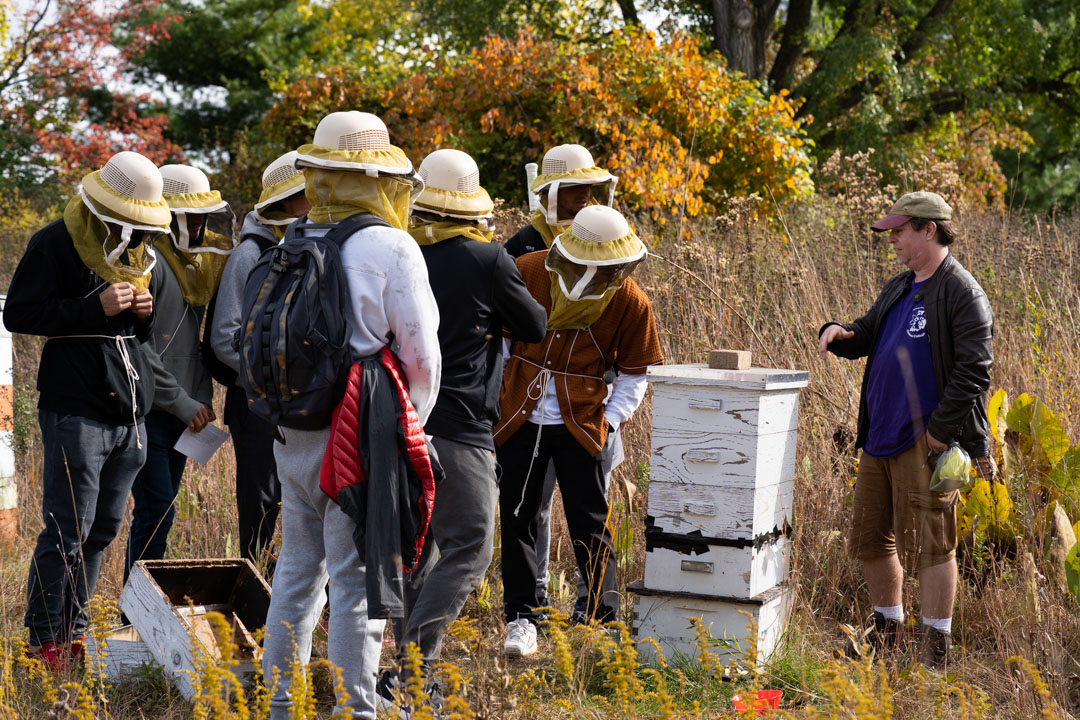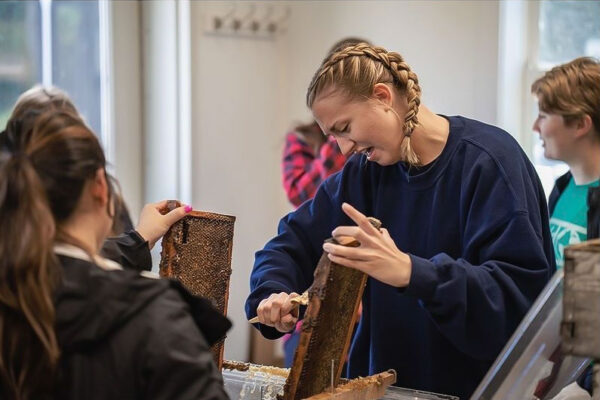Andy Ammons starts his class by taking students to the prairie behind the Newcomer Building at Goshen College. As they walk through the tall grass, students see bees flying around. This unorthodox classroom may make some students uncomfortable, but both bees and Ammons are in their natural habitat.
Ammons gets stung a lot — sometimes even on purpose. During his course, Pollinators in Peril, Ammons makes a point of stinging himself. He catches a bee and puts it directly on his arm, encouraging the bee to release the stinger. He says he does so to show the class what happens when a bee stings a person.The bee releases the stinger into the skin, leaving behind its pulsing insides. The bee usually dies within a few hours after stinging, typically a last resort to protect the hive.
The sting of a bee typically results in swelling, tender limbs and pain — but not for Ammons. He said that he has been stung so many times that he now only experiences slight swelling. He said that if you get the stinger out right away, the sting will not affect you as badly as when it lingers in the skin.
Ammons said that every year he teaches his course, a student will get stung at least once, “and it could be you, unless you wear the proper clothing.”
He encourages his students to wear long pants, long sleeve shirts, and bright colors. He does not always heed his own advice though. “I would rather not be hot,” he said, “and I’ve already been stung so many times.”
During the course, students learn about the importance of pollinators to the environment and to humans who depend on them for food. The students work with the bees very closely.
“Students learn to recognize how honey is made,” Ammons said, “and the importance of bees to nature and agriculture.”
Ammons cares deeply for his bees. “It’s hard in the spring, when I check the hives and see the ones that have died,” he said. “You have to clean out the dead bodies and that’s kind of hard … You do get attached to them.”
During class, he shows the students how to paint the bees. Using a paint marker, he is careful to color their thorax. At times, students mark too much of the bee, putting color not only on the thorax but also on the abdomen and head. Too much paint isn’t an issue for the bee, it just makes them extremely colorful.
Ammons says that beekeepers mark their bees so that they can tell which bee is which, how old the bee is and whether the bee is a queen, a worker or a drone. The queen is the biggest bee, the mother to all of the bees. The worker bees are the females, who do the jobs around the hive. The drone bees are the males, who do not have stingers.
The work also includes a reward: Ammons gets honey from the bees. For this part of the labor, he takes his students extracting at the Merry Lea Environmental Learning Center, about 45 minutes southeast of GC’s main campus.
All of the equipment and space for the extraction process is at Merry Lea. The process is simple: collect the honey frames, open the wax, put the frames in the machine, collect the honey and finally jar it.
At Merry Lea, Ammons brings around 60 frames to extract honey from. His students help with about half, and the rest is up to him. The students take on much of the work extracting the honey, including holding down the extracting device, a machine that spins to loosen the honey. They also use the extracting tools to open the wax seals and begin the process.
After the class gets through 30 frames, the process of jarring begins. A strainer is used to separate some of the honeycomb from the honey, making the honey much smoother.
Ammons was clear that life as a bee is no joke, saying, “It’s a cutthroat life to be a bee.” He said that the female bees dominate the hive. During the winter, the female worker bees kick out their brothers, the drones. Ammons said that they do this because the females don’t need the men to survive anymore and “the drones just waste space and resources.”
The worker bees keep their body heat by bundling together. In extreme cold, they can live up to a week because of how tight they pack themselves together.
Ammons is an entomologist. He studies insects and his love for them started during his childhood.
“We weren’t allowed to have pets,” he said, “so bugs were kind of mine. I would catch crickets and grasshoppers.”
It seems that Ammons has continued his love for insects into his professional life.




